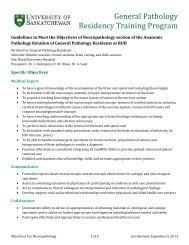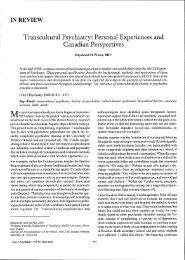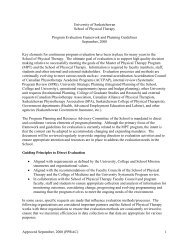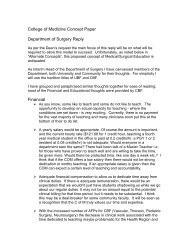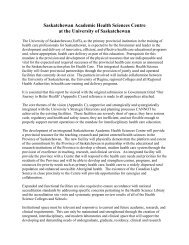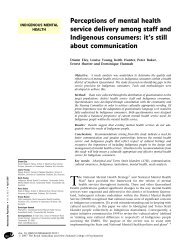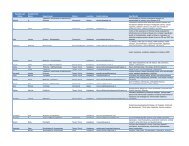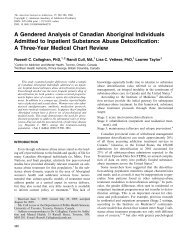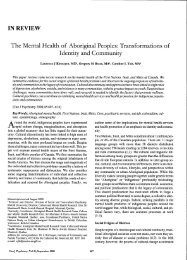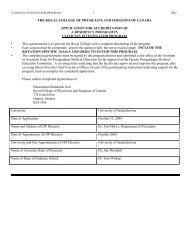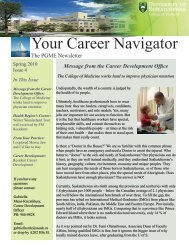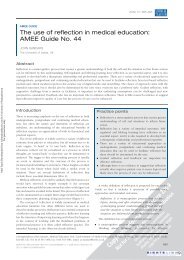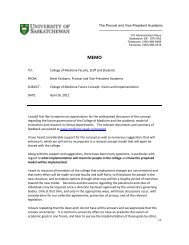Shaping Our Medical Education Journey - College of Medicine ...
Shaping Our Medical Education Journey - College of Medicine ...
Shaping Our Medical Education Journey - College of Medicine ...
Create successful ePaper yourself
Turn your PDF publications into a flip-book with our unique Google optimized e-Paper software.
Members – Why Their Research Matters...<br />
DIABETES VS. DEMOGRAPHICS<br />
Roland Dyck<br />
Pr<strong>of</strong>essor, Department <strong>of</strong> <strong>Medicine</strong><br />
THE ISSUE:<br />
In a 1937 survey, there wasn’t a single case <strong>of</strong> diabetes among<br />
Saskatchewan’s aboriginal population. By 2006, one in five individuals<br />
had been diagnosed, and the prevalence continues to rise.<br />
Though diabetes rates are increasing among all Canadians,<br />
researchers have long speculated that Aboriginal Peoples are<br />
genetically programmed to use calories sparingly, exposing them to<br />
obesity, diabetes and all the health complications that go with it.<br />
THE STUDy:<br />
Funded by the Canadian Institutes <strong>of</strong> Health Research, Health Canada,<br />
the Saskatoon Health Region and the Royal University Hospital<br />
Foundation, a team led by Roland Dyck has been researching the<br />
rise <strong>of</strong> diabetes among indigenous peoples for 20 years. The results<br />
<strong>of</strong> a recent ground-breaking study were published by the Canadian<br />
<strong>Medical</strong> Association Journal in February 2010.<br />
“The study looked at more than 90,000 people with diabetes in<br />
Saskatchewan since 1980 and gives the clearest picture to date <strong>of</strong> the<br />
demographic differences between First Nations and non-First Nations<br />
people across Canada,” says Dyck.<br />
THE FINDINGS:<br />
The first thing the study does is debunk that long-held notion<br />
<strong>of</strong> genetics.<br />
RESEARCH<br />
“It’s clear that the rapid appearance <strong>of</strong> Type 2 diabetes, particularly<br />
among First Nations populations, is due to environmental rather than<br />
genetic factors,” he says.<br />
Indeed, the epidemic is linked to rising rates <strong>of</strong> obesity, which in turn is<br />
associated with the loss <strong>of</strong> traditional lifestyles.<br />
The study also paints a distressing picture <strong>of</strong> how hard the disease<br />
has hit aboriginal communities. First Nations women aged 20 to 50<br />
experienced the heaviest burden <strong>of</strong> diabetes, and by age 60 nearly 50<br />
per cent had been diagnosed. Overall and compared to their non-First<br />
Nations counterparts, diabetes rates were four times higher among<br />
First Nations women and 2.5 times higher among First Nations men.<br />
Because diabetes strikes aboriginal women hardest during their<br />
reproductive years, women and their children are caught in an<br />
accelerating spiral. Higher rates <strong>of</strong> obesity lead to more diabetic<br />
pregnancies, which can lead to Type 2 diabetes in mother and<br />
child, and so on in future generations. Indeed, Dyck and computer<br />
scientist Nathaniel Osgood recently showed that gestational<br />
diabetes could be at the heart <strong>of</strong> 40 per cent <strong>of</strong> the epidemic<br />
among First Nations people.<br />
THE IMPACT:<br />
“Diabetes is arguably the most important chronic health issue<br />
among First Nations people and we’ve identified a key mechanism<br />
behind it,” said Dyck.<br />
Prevention <strong>of</strong> gestational diabetes could reduce the risk for Type 2<br />
diabetes in both affected women and their unborn children. This<br />
knowledge provides great potential for developing innovative<br />
initiatives in First Nations communities.<br />
Both Health Canada’s First Nations and Inuit Health Branch and its<br />
associated Aboriginal Diabetes Initiative, which reaches more than<br />
600 communities across Canada, have approached Dyck to explore<br />
ways <strong>of</strong> using his findings to provide more effective programs and<br />
services for diabetes prevention. n<br />
Article provided courtesy U <strong>of</strong> S Research Communications Office<br />
University <strong>of</strong> Saskatchewan • <strong>College</strong> <strong>of</strong> <strong>Medicine</strong> C O M M U N I Q U É 17



